Cat Food Market Size
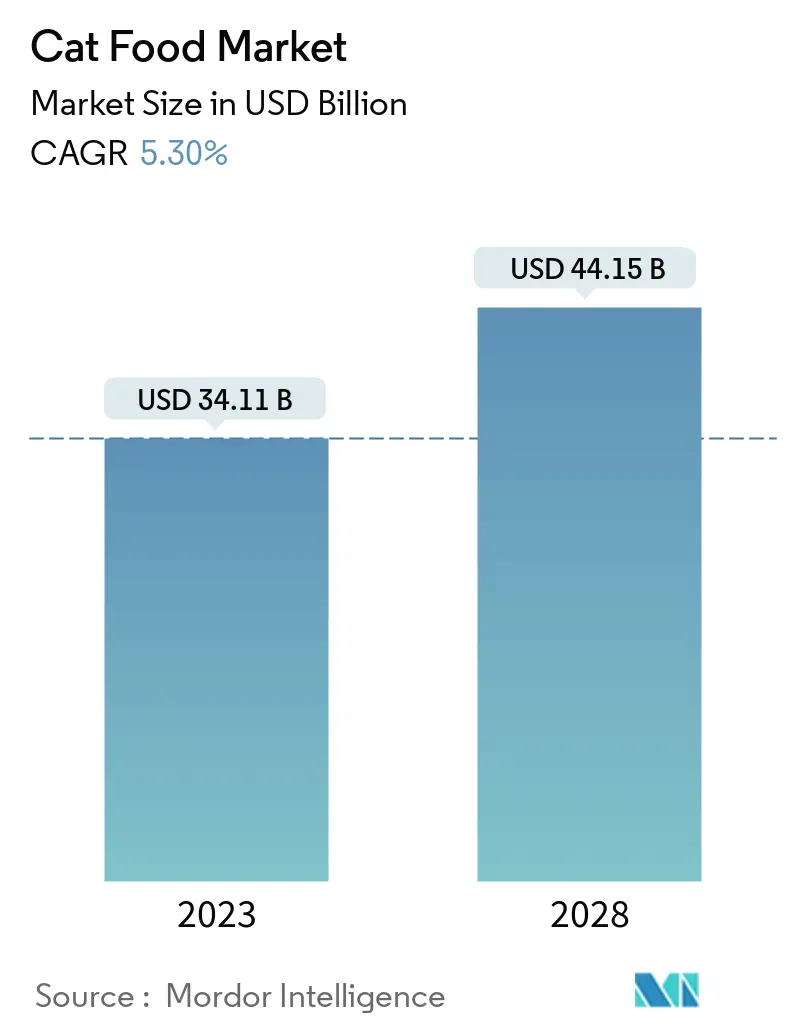
| Study Period | 2018 - 2028 |
| Market Size (2023) | USD 34.11 Billion |
| Market Size (2028) | USD 44.15 Billion |
| CAGR (2023 - 2028) | 5.30 % |
| Fastest Growing Market | Middle East and Africa |
| Largest Market | Europe |
Major Players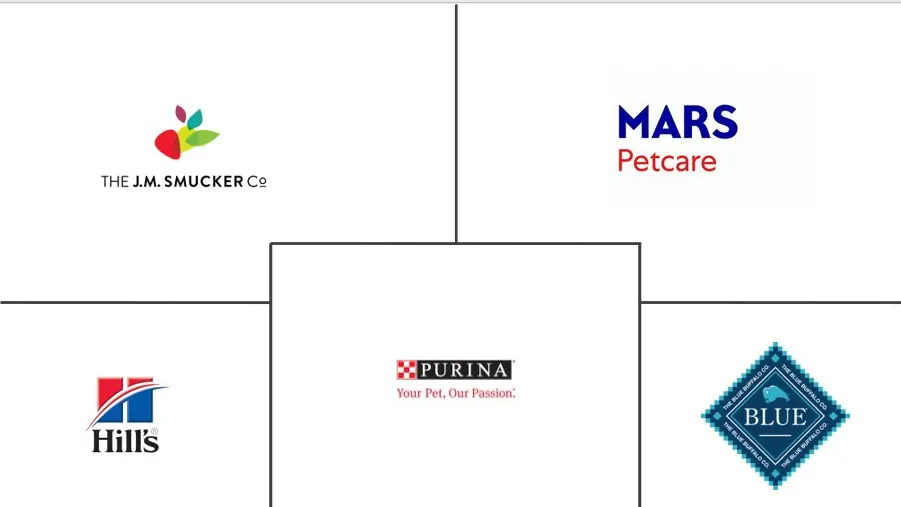
*Disclaimer: Major Players sorted in no particular order |
Need a report that reflects how COVID-19 has impacted this market and its growth?
Cat Food Market Analysis
The Cat Food Market size is estimated at USD 34.11 billion in 2023, and is expected to reach USD 44.15 billion by 2028, growing at a CAGR of 5.30% during the forecast period (2023-2028).
The imposition of the lockdown restriction due to COVID-19 affected the production facilities of several players around the world. The shelf life of cat food varies widely from four months to over a year. This helped manufacturers keep selling their products from existing stock when production was slowed down due to restrictions. In 2021, The American Pet Products Association (APPA) published the second phase of its ongoing report, 'COVID-19 Pulse Study of Pet Ownership During the Pandemic,' mentioning little to no changes in purchasing behavior and economic sentiments among pet owners in the United States.
Additionally, pet ownership and purchasing behavior have remained unchanged from May to June 2020. As per the APPA report, there was no significant change in pet owners being financially cautious about their pet product spending, with a majority (64.0%) spending the same amount from May to June. Government agencies, pet food manufacturers, and veterinarians play crucial roles in ensuring the safety of cat food and safeguarding pets and their owners. Recent legislation is expected to increase the government's role in regulating cat food and may affect many manufacturers
Cats are the second-largest consumers of pet food. They are considered obligate carnivores and require high-quality proteins and meat-predominant amino acids. Though carbohydrates are not mandatory in their diet, they can be utilized if properly cooked. Most of the dietary carbohydrates come from grains and, to a limited degree, tubers. Cats have an elevated requirement for sulfuric amino acids, like methionine, and a dietary requirement for the amino sulfone, taurine. Thus, the specific requirements of cats have enabled specialization in the industry by the companies through increased investments.
By product type, dry cat food is the largest segment in the cat food market. The cat owners prefer dry cat food as it is very economical and can be very handy to leave out for cats that eat slowly as it will not spoil over a day. It is clean, and although harder than wet food, kibble from breed-size specific foods will be small or large enough to be appropriate for the cat's mouth.
Cat Food Market Trends
This section covers the major market trends shaping the Cat Food Market according to our research experts:
Increasing Humanization and Spending on Cats
The Household and Pet Care CPG report revealed that online sales in the household and pet care category are set to grow at an increasingly rapid rate over the next five years. They are expected to increase by more than 15% between 2018 and 2022. A recent AlphaWise survey found that 66% of US households have at least one pet, with 1.7 on average. A more striking fact is that 69% of respondents "strongly agree" that their cats are essential family members, 37% would incur debt to cover a pet's medical costs, and 29% would prioritize the needs of a cat before their own. Latin America trailed North America, or Anglo-America, by a small margin. Following were the regions of Europe and the Asia-Pacific, both of which had mid-sixty percentages. A little under 60% of respondents thought of their cats as a family in the Middle East & Africa.
Between 2017 and 2020, the total retail sales of cat food increased by 12.8% yearly, with mid-priced dry and wet cat food leading the way. In the United Arab Emirates, 68.9% of all cat food sales are made up of wet products. Pet "humanization" and the nation's new pet protection law, which was created to prevent pet abandonment and abuse, particularly by nomadic ex-pats, are both driving demand for healthier goods. The increased consumer trend toward pet adoption has driven pet food premiumization, which is anticipated to expand the cat food market over the forecast period.
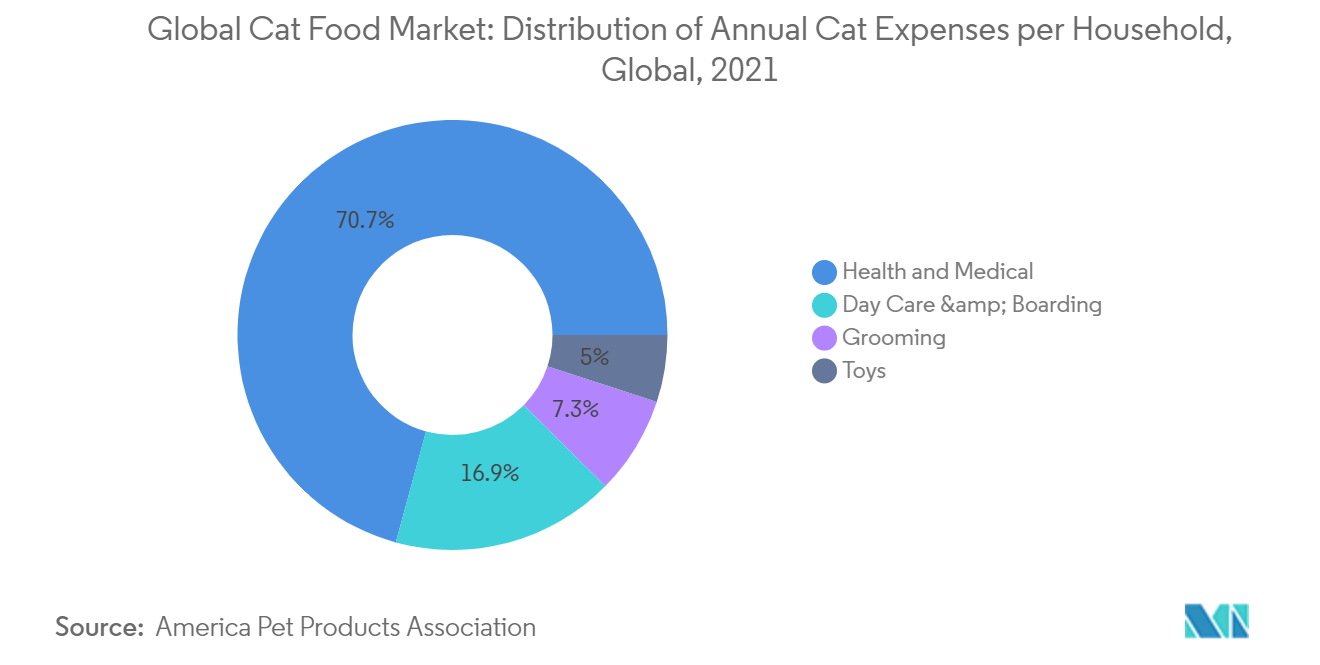
Europe is the Largest Market
Europe continues to dominate the global cat food market. The popularity of cats continued to increase during the last century in the region, according to various studies. The number of cat owners increased more than dog owners due to the relative ease of having a cat as a pet in the modern lifestyle. Dry food, wet food, and semi-moist food are the major types of commercial cat food.
Germany, the largest economy in the European Union, is a big and promising cat food market. The German industry is mature and somewhat saturated, although it is steadily growing. German cat owners are trending toward products that ‘humanize’ the care of their cats, and in response, manufacturers have developed premium cat foods focusing on health and wellness. The trends in the cat food sector often correspond to those in human nutrition. Companies are offering an increasing number of premium products as consumers are prepared to spend more on pet food that is healthy, nutritious, and improves their living conditions. For instance, in 2020, the German pet treat company Gimborn launched a line of functional pet treats. The products include squeezables, oil-based liquid treats, and munchables and crunchy treats for cats. The consumer trend toward cat adoption has driven cat food premiumization, which is anticipated to create an expansion of the cat food market over the forecast period.
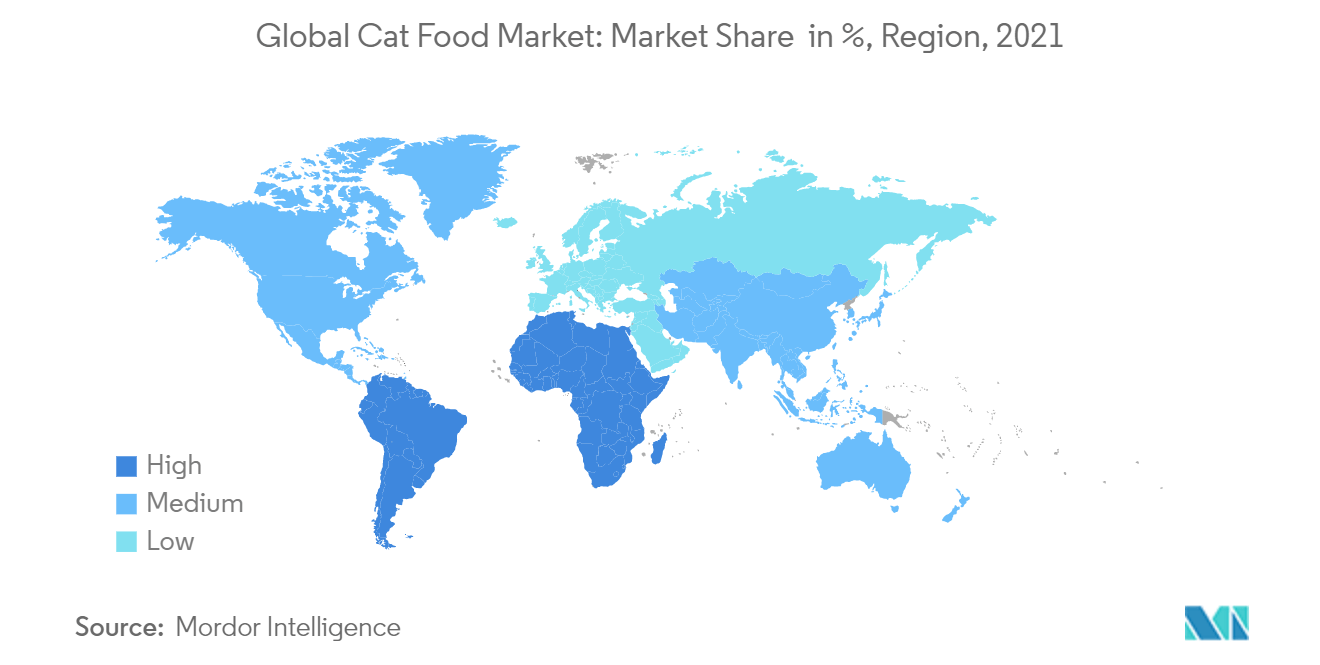
Cat Food Industry Overview
The cat food market is moderately consolidated, with major global players occupying large market shares and competing fiercely with local players and private labels. The major players in the global cat food market include Nestle SA, Mars Inc, Hills Pet Nutrition Inc., The J.M. Smucker, and Blue Buffalo Company. Consisting heavily of large multinational players, the market also houses many private-label players. Apart from the presence of a loyal customer base, the major players in the market benefit from substantial marketing and innovation capacities.
Cat Food Market Leaders
Mars Petcare
Nestle Purina PetCare Company
Hill's Pet Nutrition
J.M Smucker
Blue Buffalo Company
*Disclaimer: Major Players sorted in no particular order
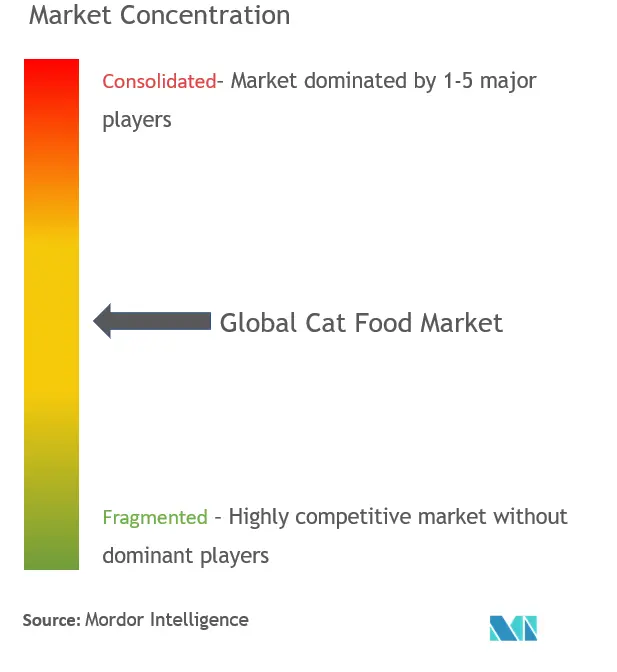
Cat Food Market News
In January 2022, Mars Petcare acquired Nom Nom Now, a direct-to-consumer fresh pet food brand based in Tennessee, United States, and will integrate the brand within its Royal Canin division. NomNomNow, whose brand name is Nom Nom, sells fresh food, treats, and supplements for cats.
In November 2021, Hill's Pet Nutrition and the Boulder-based leader in creating meat proteins via fermentation for pet food applications, announced an industry-first partnership to develop an alternative to one of Hill's most popular meat proteins, specifically to address the dietary needs of cats.
In December 2021, Beaphar acquired super-premium pet food company Pet Food UK from Piper. It houses the key brands, “Barking Heads” for dogs and “Meowing Heads” for cats. This acquisition has strengthened the existing product portfolio and distribution channels of the company
Cat Food Market Report - Table of Contents
1. INTRODUCTION
1.1 Study Assumptions and Market Definition
1.2 Scope of the Study
2. RESEARCH METHODOLOGY
3. EXECUTIVE SUMMARY
4. MARKET DYNAMICS
4.1 Market Overview
4.2 Market Drivers
4.3 Market Restraints
4.4 Porter's Five Forces Analysis
4.4.1 Bargaining Power of Suppliers
4.4.2 Bargaining Power of Buyers
4.4.3 Threat of New Entrants
4.4.4 Threat of Substitute Products
4.4.5 Intensity of Competitive Rivalry
5. MARKET SEGMENTATION
5.1 Product Type
5.1.1 Dry Cat Food
5.1.2 Wet Cat Food
5.1.3 Veterinary Diets
5.1.4 Treats/Snacks
5.1.5 Organic Products
5.2 Ingredient Type
5.2.1 Animal-derived
5.2.2 Plant-derived
5.2.3 Cereals and Cereal By-products
5.2.4 Other Ingredient Types
5.3 Sales Channel
5.3.1 Specialized Pet Shops
5.3.2 Internet Sales
5.3.3 Hypermarkets/Supermarkets
5.3.4 Other Sales Channels
5.4 Pricing Type
5.4.1 Economy Segment
5.4.2 Premium Segment
5.4.3 Super-premium Segment
5.5 Geography
5.5.1 North America
5.5.1.1 United States
5.5.1.2 Canada
5.5.1.3 Mexico
5.5.1.4 Rest of North America
5.5.2 Europe
5.5.2.1 Germany
5.5.2.2 United Kingdom
5.5.2.3 France
5.5.2.4 Spain
5.5.2.5 Italy
5.5.2.6 Russia
5.5.2.7 Rest of Europe
5.5.3 Asia Pacific
5.5.3.1 China
5.5.3.2 India
5.5.3.3 Japan
5.5.3.4 Australia
5.5.3.5 Rest of Asia Pacific
5.5.4 South America
5.5.4.1 Brazil
5.5.4.2 Argentina
5.5.4.3 Rest of South America
5.5.5 Middle-East and Africa
5.5.5.1 Saudi Arabia
5.5.5.2 South Africa
5.5.5.3 Rest of Middle-East and Africa
6. COMPETITIVE LANDSCAPE
6.1 Most Adopted Strategies
6.2 Market Share Analysis
6.3 Company Profiles
6.3.1 Mars Inc.
6.3.2 Nestle Purina PetCare Company
6.3.3 Hill's Pet Nutrition
6.3.4 Blue Buffalo Company
6.3.5 Canidae Natural Pet Food Company
6.3.6 The JM Smucker Company
6.3.7 Nutro
6.3.8 Beaphar
6.3.9 Diamond Pet Foods
6.3.10 PetGuard
6.3.11 Harringtons
6.3.12 Royal Canin
6.3.13 Nutriara Alimentos Ltda
7. MARKET OPPORTUNITIES AND FUTURE TRENDS
8. AN ASSESSMENT OF IMPACT OF COVID-19 ON THE MARKET
Cat Food Industry Segmentation
The Cat Food Market is Segmented by Product (Dry Cat Food, Wet Cat Food, Veterinary Diet, Treats/Snacks, and Organic Products), Ingredient Type ( Animal-derived, Plant-derived, Cereal and Cereal By-products, and Other Ingredient Types), Sales Channel (Specialized Pet Shop, Internet Sales, Hypermarkets/Supermarkets, and Other Sales Channels), Pricing Type (Economy Segment, Premium Segment, and Super-premium Segment), and Geography (North America, Europe, Asia Pacific, South America, and Middle-East and Africa). The report offers the market size and forecasts in terms of value in USD million for all the above segments.
| Product Type | |
| Dry Cat Food | |
| Wet Cat Food | |
| Veterinary Diets | |
| Treats/Snacks | |
| Organic Products |
| Ingredient Type | |
| Animal-derived | |
| Plant-derived | |
| Cereals and Cereal By-products | |
| Other Ingredient Types |
| Sales Channel | |
| Specialized Pet Shops | |
| Internet Sales | |
| Hypermarkets/Supermarkets | |
| Other Sales Channels |
| Pricing Type | |
| Economy Segment | |
| Premium Segment | |
| Super-premium Segment |
| Geography | |||||||||
| |||||||||
| |||||||||
| |||||||||
| |||||||||
|
Cat Food Market Research FAQs
How big is the Cat Food Market?
The Cat Food Market size is expected to reach USD 34.11 billion in 2023 and grow at a CAGR of 5.30% to reach USD 44.15 billion by 2028.
What is the current Cat Food Market size?
In 2023, the Cat Food Market size is expected to reach USD 34.11 billion.
Who are the key players in Cat Food Market?
Mars Petcare, Nestle Purina PetCare Company, Hill's Pet Nutrition, J.M Smucker and Blue Buffalo Company are the major companies operating in the Cat Food Market.
Which is the fastest growing region in Cat Food Market?
Middle East and Africa is estimated to grow at the highest CAGR over the forecast period (2023-2028).
Which region has the biggest share in Cat Food Market?
In 2023, the Europe accounts for the largest market share in the Cat Food Market.
Cat Food Industry Report
Statistics for the 2023 Cat Food market share, size and revenue growth rate, created by Mordor Intelligence™ Industry Reports. Cat Food analysis includes a market forecast outlook to 2028 and historical overview. Get a sample of this industry analysis as a free report PDF download.
